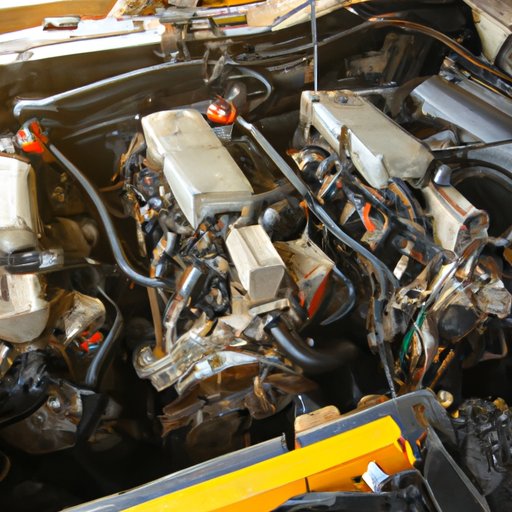Introduction
Diesel engines are powerful machines used to convert energy into mechanical force. They’re found in everything from automobiles and trucks to boats, trains, and construction equipment. But how do these engines work? In this article, we’ll explore the mechanics of diesel engines and provide a step-by-step guide to understanding how they work.
Exploring the Mechanics of the Diesel Engine
Before we dive into the nitty-gritty of diesel engines, let’s start with a basic overview of what they are and why they’re so important.
What is a Diesel Engine?
Diesel engines are internal combustion engines that use compression to ignite the fuel. Unlike gasoline engines, which rely on spark plugs to ignite the fuel, diesel engines rely solely on heat generated by air compression for ignition. This makes them more efficient than gasoline engines and allows them to generate higher amounts of torque.
How Does A Diesel Engine Work?
In a nutshell, a diesel engine converts fuel into mechanical energy by using four strokes: intake, compression, combustion, and exhaust. During the intake stroke, air is drawn into the cylinder, where it’s compressed during the compression stroke. Fuel is then injected into the cylinder during the combustion stroke, where it ignites due to the high temperature created by the compression. Finally, the exhaust stroke pushes out the used gases.
A Step-by-Step Guide to Understanding How a Diesel Engine Works
Now that we’ve covered the basics, let’s dive deeper into the mechanics of diesel engines. Here’s a step-by-step guide to understanding how a diesel engine works.
The Four Strokes of a Diesel Cycle
As mentioned above, diesel engines use four strokes to convert fuel into mechanical energy. These are the intake, compression, combustion, and exhaust strokes.
The intake stroke begins when the piston moves down the cylinder, creating a vacuum that draws air into the cylinder. This air is then compressed during the compression stroke as the piston moves back up the cylinder. The compressed air increases the temperature inside the cylinder, which is necessary for ignition.
During the combustion stroke, fuel is injected into the cylinder and ignited by the high temperature. The burning fuel expands and forces the piston back down the cylinder, creating mechanical energy. Finally, the exhaust stroke pushes out the used gases.
Injectors and Combustion
In order for the combustion stroke to be successful, fuel must be injected into the cylinder at just the right time and in the correct amount. This is done via fuel injectors, which open at precise intervals controlled by the engine’s computer. The injectors also control the amount of fuel that is injected into the cylinder. Too much fuel can cause smoke and poor engine performance, while too little fuel can lead to incomplete combustion, resulting in lower power output.

The Anatomy of a Diesel Engine
Now that we’ve discussed the four strokes of a diesel cycle, let’s take a look at the major components of a diesel engine.
Major Components of a Diesel Engine
The major components of a diesel engine include the fuel system, ignition system, cooling system, and exhaust system.
Fuel System
The fuel system is responsible for delivering fuel to the engine. It consists of a fuel tank, pump, filter, and injectors. The fuel tank stores the fuel, while the pump delivers it to the injectors. The filter removes impurities from the fuel, and the injectors spray the fuel into the cylinders.
Ignition System
The ignition system is responsible for igniting the fuel. It consists of a spark plug, glow plug, or other device that produces a spark. Without this spark, the fuel will not ignite.
Cooling System
The cooling system is responsible for keeping the engine cool. It consists of a radiator, water pump, and thermostat. The radiator dissipates heat, while the water pump circulates coolant through the engine. The thermostat regulates the temperature of the engine by opening and closing as necessary.
Comparing Gas and Diesel Engines: What Makes Diesel Different?
Now that we’ve explored the anatomy of diesel engines, let’s take a look at how they compare to gas engines. Here are some of the key differences between diesel and gas engines.
Efficiency
Diesel engines are more efficient than gasoline engines because they use compression to ignite the fuel, rather than spark plugs. This means that less fuel is wasted, resulting in better fuel economy.
Power
Due to their higher compression ratio, diesel engines produce more torque than gasoline engines, making them ideal for heavy-duty applications such as trucks and construction equipment.
Maintenance
Diesel engines require more frequent maintenance than gasoline engines, but they tend to last longer due to their robust construction. Common maintenance tasks for diesel engines include fuel filters, glow plugs, and oil changes.
Conclusion
Diesel engines are powerful and efficient machines that convert fuel into mechanical energy. By understanding the mechanics of diesel engines and how they differ from gas engines, you can ensure that your engine runs smoothly and efficiently. We hope this article has been helpful in understanding how diesel engines work and the key differences between diesel and gas engines.
(Note: Is this article not meeting your expectations? Do you have knowledge or insights to share? Unlock new opportunities and expand your reach by joining our authors team. Click Registration to join us and share your expertise with our readers.)
